New York's congressional districts
The U.S. state of New York currently comprises 27 congressional districts. Each district elects one member of the United States House of Representatives who sits on its behalf.[2] The state was redistricted in 2013, following the 2010 U.S. Census; it lost two seats in Congress.[3]

Current districts and representatives
List of members of the New York United States House delegation, district boundaries, and district political ratings according to the CPVI. The delegation has a total of 26 members, with 21 Democrats and 6 Republicans as of 2020.
| District | CPVI | Representative (Residence) |
Party | In office since | District map |
|---|---|---|---|---|---|
| 1st | R+5 | 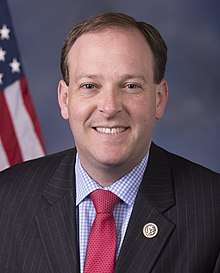 Lee Zeldin (Shirley) |
Republican | January 3, 2015 | .tif.png) |
| 2nd | R+3 |  Peter King (Seaford) |
Republican | January 3, 1993 | .tif.png) |
| 3rd | D+1 | 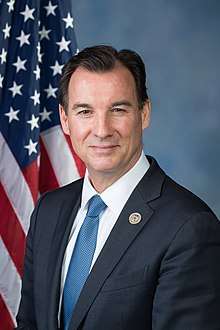 Thomas Suozzi (Glen Cove) |
Democratic | January 3, 2017 | .tif.png) |
| 4th | D+4 | .jpg) Kathleen Rice (Garden City) |
Democratic | January 3, 2015 | .tif.png) |
| 5th | D+37 | 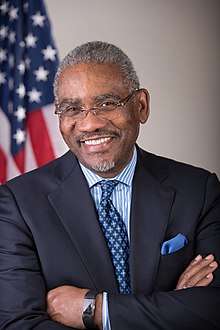 Gregory Meeks (Queens) |
Democratic | February 3, 1998 | .tif.png) |
| 6th | D+16 | 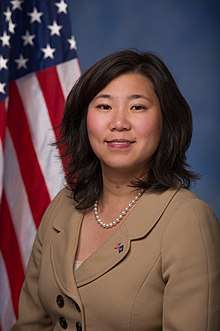 Grace Meng (Queens) |
Democratic | January 3, 2013 | .tif.png) |
| 7th | D+38 | .jpg) Nydia Velázquez (Brooklyn) |
Democratic | January 3, 1993 | .tif.png) |
| 8th | D+36 |  Hakeem Jeffries (Brooklyn) |
Democratic | January 3, 2013 | .tif.png) |
| 9th | D+34 |  Yvette Clarke (Brooklyn) |
Democratic | January 3, 2007 | .tif.png) |
| 10th | D+26 | .jpg) Jerry Nadler (Manhattan) |
Democratic | November 3, 1992 | .tif.png) |
| 11th | R+3 | 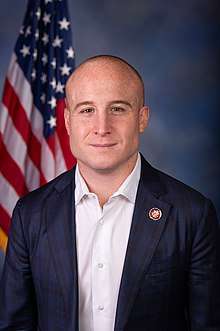 Max Rose (Staten Island) |
Democratic | January 3, 2019 | .tif.png) |
| 12th | D+31 |  Carolyn Maloney (Manhattan) |
Democratic | January 3, 1993 | .tif.png) |
| 13th | D+43 | 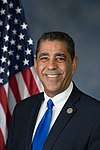 Adriano Espaillat (Manhattan) |
Democratic | January 3, 2017 | .tif.png) |
| 14th | D+29 |  Alexandria Ocasio-Cortez (Bronx) |
Democratic | January 3, 2019 | .tif.png) |
| 15th | D+44 |  José E. Serrano (Bronx) |
Democratic | March 21, 1990 | .tif.png) |
| 16th | D+24 | 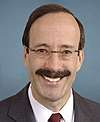 Eliot Engel (Bronx) |
Democratic | January 3, 1989 | .tif.png) |
| 17th | D+7 |  Nita Lowey (Harrison) |
Democratic | January 3, 1989 | .tif.png) |
| 18th | R+1 | 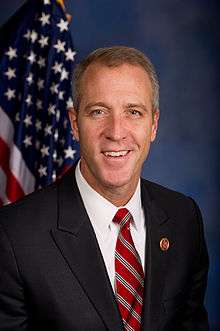 Sean Maloney (Carmel) |
Democratic | January 3, 2013 | .tif.png) |
| 19th | R+2 | 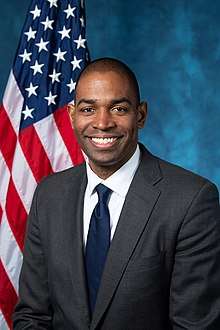 Antonio Delgado (Rhinebeck) |
Democratic | January 3, 2019 | .tif.png) |
| 20th | D+7 | 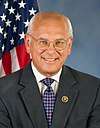 Paul Tonko (Amsterdam) |
Democratic | January 3, 2009 | .tif.png) |
| 21st | R+4 | 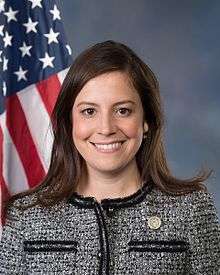 Elise Stefanik (Schuylerville) |
Republican | January 3, 2015 | .tif.png) |
| 22nd | R+6 |  Anthony Brindisi (Utica) |
Democratic | January 3, 2019 | .tif.png) |
| 23rd | R+6 |  Tom Reed (Corning) |
Republican | November 18, 2010 | .tif.png) |
| 24th | D+3 |  John Katko (Camillus) |
Republican | January 3, 2015 | .tif.png) |
| 25th | D+8 | .jpg) Joseph Morelle (Irondequoit) |
Democratic | November 13, 2018 | .tif.png) |
| 26th | D+11 | 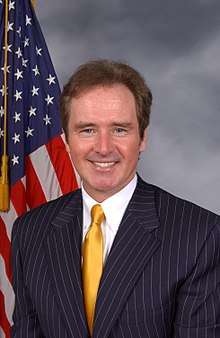 Brian Higgins (Buffalo) |
Democratic | January 3, 2005 | .tif.png) |
| 27th | R+11 | 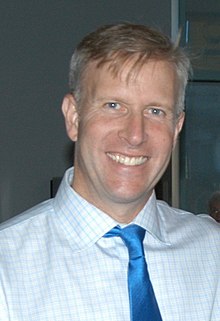 Chris Jacobs (Orchard Park) |
Republican | July 21, 2020[4] | .tif.png) |
Historical district locations
Note: There are now 62 counties in New York (state). The counties that are not mentioned in this list had not yet been established, or sufficiently organized.
1789 elections
On January 27, 1789, the New York State Legislature divided the State of New York into six congressional districts which were not numbered.[5]
- Kings, Queens, Richmond and Suffolk counties.
- New York City, and Westchester County except the towns of Salem, North Salem, Cortland, Yorktown and Stephentown.
- Dutchess County and the abovementioned towns in Westchester.
- Orange and Ulster counties.
- Albany County east of the Hudson River, Columbia, Clinton and Washington counties.
- Albany County west of the Hudson River, and Montgomery and Ontario counties.
1790 elections
The districts remained the same as for the previous elections in March 1789.
1793 elections
On December 18, 1792, the Legislature divided the State into ten districts, which were still not numbered, taking into account the new counties created in 1791.
- Kings, Queens and Suffolk counties.
- New York County.
- Westchester and Richmond counties.
- Orange and Ulster counties.
- Dutchess County.
- Columbia County.
- Clinton and Rensselaer counties.
- Albany County.
- Washington and Saratoga counties.
- Montgomery, Ontario, Herkimer, Otsego and Tioga counties.
1794 elections
The congressional districts remained at this election the same as at the previous election, only inside the tenth district a new county, Onondaga, was created in 1794.
- Kings, Queens and Suffolk counties.
- New York County.
- Westchester and Richmond counties.
- Orange and Ulster counties.
- Dutchess County.
- Columbia County.
- Clinton and Rensselaer counties.
- Albany County.
- Washington and Saratoga counties.
- Montgomery, Ontario, Herkimer, Otsego, Tioga and Onondaga counties.
1796 elections
The geographical area of the congressional districts remained at this election the same as at the previous election in December 1794. A new county was created, Schoharie County Most of the new Schoharie County was taken from Albany County, and remained in the 8th district, a part was taken from Otsego County, and remained in the 10th district. Besides, inside the 10th district a new county had been created: Steuben County.
- Kings, Queens and Suffolk counties.
- New York County.
- Westchester and Richmond counties.
- Orange and Ulster counties.
- Dutchess County.
- Columbia County.
- Clinton and Rensselaer counties.
- Albany and Schoharie counties.
- Washington and Saratoga counties.
- Montgomery, Ontario, Herkimer, Otsego, Tioga, Onondaga and Steuben counties.
1798 elections
On March 27, 1797, the Legislature re-apportioned the districts, taking into account the new counties which had been created in the meanwhile, and for the first time the districts were numbered.
- 1st district: Kings, Queens, Suffolk and Richmond counties.
- 2nd district: The first six wards of New York County.
- 3rd district: The 7th Ward of New York County, and Westchester and Rockland[6] counties.
- 4th district: Orange, Ulster and Delaware counties.
- 5th district: Dutchess County.
- 6th district: Columbia and Rensselaer counties.
- 7th district: Clinton, Saratoga and Washington counties.
- 8th district: Albany and Schoharie counties.
- 9th district: Herkimer, Montgomery, Chenango and Oneida counties.
- 10th district: Ontario, Otsego, Tioga, Onondaga and Steuben counties.
1800 elections
The districts remained the same as at the previous election in April 1798, but two new counties were created in 1799: in the 7th district, Essex County was split from Clinton County; and in the 10th district, Cayuga County was split from Onondaga County.
- 1st district: Kings, Queens, Suffolk and Richmond counties.
- 2nd district: The first six wards of New York County.
- 3rd district: The 7th Ward of New York County, and Westchester and Rockland[6] counties.
- 4th district: Orange, Ulster and Delaware counties.
- 5th district: Dutchess County.
- 6th district: Columbia and Rensselaer counties.
- 7th district: Clinton, Saratoga, Washington and Essex counties.
- 8th district: Albany and Schoharie counties.
- 9th district: Herkimer, Montgomery, Chenango and Oneida counties.
- 10th district: Ontario, Otsego, Tioga, Onondaga, Steuben and Cayuga counties.
1802 elections
Until the previous elections, there had been ten congressional districts. After the U.S. census of 1800, Congress re-apportioned the seats, and New York's representation was increased to 17. On March 30, 1802, the New York State Legislature re-apportioned the congressional districts, dividing New York County seemingly at random into two districts.
- 1st district: Queens and Suffolk counties.
- 2nd district: The 1st, 2nd, 3rd and 5th Ward of New York County; and Kings and Richmond counties.
- 3rd district: The 4th, 6th and 7th Ward of New York County.
- 4th district: Westchester and Rockland counties.
- 5th district: Orange County.
- 6th district: Dutchess County.
- 7th district: Ulster and Greene counties.
- 8th district: Columbia County.
- 9th district: Albany County.
- 10th district: Rensselaer County.
- 11th district: Clinton, Saratoga and Essex counties.
- 12th district: Washington County.
- 13th district: Montgomery and Schoharie counties.
- 14th district: Delaware and Otsego counties.
- 15th district: Herkimer and Oneida counties.
- 16th district: Chenango, Tioga and Onondaga counties.
- 17th district: Ontario, Steuben and Cayuga counties.
1804 elections
After the election of one Democratic-Republican and one Federalist in 1802, the Democratic-Republican majority in the State Legislature gerrymandered the two districts together in an Act passed on March 20, 1804, so that two congressmen would be elected on a general ticket by the voters of both districts, assuring the election of two Democratic-Republicans.
Besides, Seneca County was split from Cayuga County inside the 17th district.
- 1st district: Queens and Suffolk counties.
- 2nd district and 3rd district (two seats): New York, Kings and Richmond counties.
- 4th district: Westchester and Rockland counties.
- 5th district: Orange County.
- 6th district: Dutchess County.
- 7th district: Ulster and Greene counties.
- 8th district: Columbia County.
- 9th district: Albany County.
- 10th district: Rensselaer County.
- 11th district: Clinton, Saratoga and Essex counties.
- 12th district: Washington County.
- 13th district: Montgomery and Schoharie counties.
- 14th district: Delaware and Otsego counties.
- 15th district: Herkimer and Oneida counties.
- 16th district: Chenango, Tioga and Onondaga counties.
- 17th district: Ontario, Steuben, Cayuga and Seneca counties.
1806 elections
Three new counties had been created since the last elections in 1804: inside the 15th district, Jefferson County was split off from Oneida County; in the 16th district, Madison County from Chenango County; and in the 17th district, Allegany County from Genesee County The area of the districts remained the same.
- 1st district: Queens and Suffolk counties.
- 2nd district and 3rd district (two seats): New York, Kings and Richmond counties.
- 4th district: Westchester and Rockland counties.
- 5th district: Orange County.
- 6th district: Dutchess County.
- 7th district: Ulster and Greene counties.
- 8th district: Columbia County.
- 9th district: Albany County.
- 10th district: Rensselaer County.
- 11th district: Clinton, Saratoga and Essex counties.
- 12th district: Washington County.
- 13th district: Montgomery and Schoharie counties.
- 14th district: Delaware and Otsego counties.
- 15th district: Herkimer, Oneida and Jefferson counties.
- 16th district: Chenango, Tioga, Onondaga and Madison counties.
- 17th district: Ontario, Steuben, Cayuga, Seneca and Allegany counties.
1808 elections
On April 8, 1808, the State Legislature re-apportioned the districts again, separating the 2nd and the 3rd district, and creating two districts with two seats each to be filled on a general ticket: the 2nd and the 6th.
David Thomas had been elected in the old 12th district which had comprised only Washington County, so the vacancy was filled by a special election held only in this county, while at the same time two representatives were elected on a general ticket in the new 6th district to which Washington County had been re-districted together with Columbia County and Rensselaer County.
Due to the double-seat districts, there were then only 15 districts; the 16th and 17th were eliminated.
- 1st district: Kings, Queens and Suffolk counties.
- 2nd district (two seats): New York, Richmond and Rockland counties.
- 3rd district: Orange and Westchester counties.
- 4th district: Dutchess County.
- 5th district: Ulster, Greene counties.
- 6th district (two seats): Columbia, Rensselaer and Washington counties.
- 7th district: Albany County.
- 8th district: Clinton, Saratoga and Essex counties.
- 9th district: Montgomery and Schoharie counties.
- 10th district: Herkimer, St. Lawrence, Jefferson and Lewis counties.
- 11th district: Oneida and Madison counties.
- 12th district: Delaware and Otsego counties.
- 13th district: Chenango, Onondaga, Broome and Cortland counties.
- 14th district: Tioga, Steuben, Cayuga and Seneca counties.
- 15th district: Ontario, Genesee and Allegany counties.
Note: There are now 62 counties in the State of New York. The counties which are not mentioned in this list had not yet been established, or sufficiently organized, the area being included in one or more of the above-mentioned counties.
1810 elections
The districts remained the same as at the previous elections in 1808. Only four new counties were created inside some districts: in the 5th district, Sullivan County was split from Ulster County; in the 7th district, Schenectady County was split from Albany County; in the 8th district, Franklin County was split from Clinton County; and in the 15th district, Niagara County was split from Genesee County.
- 1st district: Kings, Queens and Suffolk counties.
- 2nd district (two seats): New York, Richmond and Rockland counties.
- 3rd district: Orange and Westchester counties.
- 4th district: Dutchess County.
- 5th district: Ulster, Greene and Sullivan counties.
- 6th district (two seats): Columbia, Rensselaer and Washington counties.
- 7th district: Albany and Schenectady counties.
- 8th district: Clinton, Saratoga, Essex and Franklin counties.
- 9th district: Montgomery and Schoharie counties.
- 10th district: Herkimer, St. Lawrence, Jefferson and Lewis counties.
- 11th district: Oneida and Madison counties.
- 12th district: Delaware and Otsego counties.
- 13th district: Chenango, Onondaga, Broome and Cortland counties.
- 14th district: Tioga, Steuben, Cayuga and Seneca counties.
- 15th district: Ontario, Genesee, Allegany and Niagara counties.
1812 elections
Due to the increase in seats, the previously eliminated 16th and 17th district were re-established, and four more districts were created. Six districts had two members, elected districtwide on a general ticket.
- 1st district (two seats): The 1st and 2nd Ward of New York County, and Kings, Queens, Suffolk and Richmond counties.
- 2nd district (two seats): The other eight wards of New York County.
- 3rd district: Westchester and Rockland counties.
- 4th district: Dutchess County, except the towns of Rhinebeck and Clinton; and Putnam County.
- 5th district: Columbia County; and Rhinebeck and Clinton in Dutchess County.
- 6th district: Orange County.
- 7th district: Ulster and Sullivan counties.
- 8th district: Delaware and Greene counties.
- 9th district: Albany County.
- 10th district: Rensselaer County.
- 11th district: Saratoga County.
- 12th district (two seats): Clinton, Essex, Franklin and Washington counties.
- 13th district: Schenectady and Schoharie counties.
- 14th district: Montgomery County.
- 15th district (two seats): Chenango, Broome and Otsego counties.
- 16th district: Oneida County.
- 17th district: Herkimer and Madison counties.
- 18th district: St. Lawrence, Jefferson and Lewis counties.
- 19th district: Onondaga and Cortland counties.
- 20th district (two seats): Tioga, Steuben, Cayuga and Seneca counties.
- 21st district (two seats): Ontario, Genesee, Allegany, Niagara and Chautauqua counties.
1814 elections
For the 1814 elections, the districts remained the same as at the previous elections in 1812, only one new county was created: in the 12th district, Warren County was split from Washington County.
- 1st district (two seats): The 1st and 2nd Ward of New York County, and Kings, Queens, Suffolk and Richmond counties.
- 2nd district (two seats): The other eight wards of New York County.
- 3rd district: Westchester and Rockland counties.
- 4th district: Dutchess County, except the towns of Rhinebeck and Clinton; and Putnam County.
- 5th district: Columbia County; and Rhinebeck and Clinton in Dutchess County.
- 6th district: Orange County.
- 7th district: Ulster and Sullivan counties.
- 8th district: Delaware and Greene counties.
- 9th district: Albany County.
- 10th district: Rensselaer County.
- 11th district: Saratoga County.
- 12th district (two seats): Clinton, Essex, Franklin, Washington and Warren counties.
- 13th district: Schenectady and Schoharie counties.
- 14th district: Montgomery County.
- 15th district (two seats): Chenango, Broome and Otsego counties.
- 16th district: Oneida County.
- 17th district: Herkimer and Madison counties.
- 18th district: St. Lawrence, Jefferson and Lewis counties.
- 19th district: Onondaga and Cortland counties.
- 20th district (two seats): Tioga, Steuben, Cayuga and Seneca counties.
- 21st district (two seats): Ontario, Genesee, Allegany, Niagara and Chautauqua counties.
1816 elections
For the 1816 elections, there was no change.
1818 elections
For the 1818 elections, the geographical area of the districts remained the same as at the previous elections in 1816. Two new counties were created: Tompkins inside the 20th district; and Cattaraugus inside the 21st district. In 1817, the Town of Danube was separated from the Town of Minden in Montgomery County, and transferred to Herkimer County, but Danube remained in the 14th district.
- 1st district (two seats): The 1st and 2nd Ward of New York County, and Kings, Queens, Suffolk and Richmond counties.
- 2nd district (two seats): The other eight wards of New York County.
- 3rd district: Westchester and Rockland counties.
- 4th district: Dutchess County, except the towns of Rhinebeck and Clinton; and Putnam County.
- 5th district: Columbia County; and Rhinebeck and Clinton in Dutchess County.
- 6th district: Orange County.
- 7th district: Ulster and Sullivan counties.
- 8th district: Delaware and Greene counties.
- 9th district: Albany County.
- 10th district: Rensselaer County.
- 11th district: Saratoga County.
- 12th district (two seats): Clinton, Essex, Franklin, Washington and Warren counties.
- 13th district: Schenectady and Schoharie counties.
- 14th district: Montgomery County and the Town of Danube in Herkimer County.
- 15th district (two seats): Chenango, Broome and Otsego counties.
- 16th district: Oneida County.
- 17th district: Herkimer County, except the Town of Danube, and Madison County.
- 18th district: St. Lawrence, Jefferson and Lewis counties.
- 19th district: Onondaga and Cortland counties.
- 20th district (two seats): Tioga, Steuben, Cayuga, Seneca and Tompkins counties.
- 21st district (two seats): Ontario, Genesee, Allegany, Niagara, Chautauqua and Cattaraugus counties.
1821 elections
For the 1821 elections, except for the split of the 21st district, the geographical area of the congressional districts remained the same as at the previous elections in 1818. Five new counties had been created. Hamilton County was split from Montgomery County inside the 14th district. Oswego County was created from parts of Oneida and Onondaga counties, but the parts remained in their previous congressional districts. On March 9, 1821, the New York State Legislature divided the 21st district in two districts: Ontario County and the newly created Monroe County remained as the 21st district; the remainder became the new 22nd district, including the new counties of Erie and Livingston.
- 1st district (two seats): The 1st and 2nd Ward of New York County, and Kings, Queens, Suffolk and Richmond counties.
- 2nd district (two seats): The other eight wards of New York County.
- 3rd district: Westchester and Rockland counties.
- 4th district: Dutchess County, except the towns of Rhinebeck and Clinton; and Putnam County.
- 5th district: Columbia County; and Rhinebeck and Clinton in Dutchess County.
- 6th district: Orange County.
- 7th district: Ulster and Sullivan counties.
- 8th district: Delaware and Greene counties.
- 9th district: Albany County.
- 10th district: Rensselaer County.
- 11th district: Saratoga County.
- 12th district (two seats): Clinton, Essex, Franklin, Washington and Warren counties.
- 13th district: Schenectady and Schoharie counties.
- 14th district: Montgomery County and the Town of Danube in Herkimer County.
- 15th district (two seats): Chenango, Broome and Otsego counties.
- 16th district: Oneida County and the ex-Oneida part of Oswego County.
- 17th district: Herkimer County, except the Town of Danube; and Madison County.
- 18th district: St. Lawrence, Jefferson and Lewis counties.
- 19th district: Onondaga and Cortland counties, and the ex-Onondaga part of Oswego County.
- 20th district (two seats): Tioga, Steuben, Cayuga, Seneca and Tompkins counties.
- 21st district: Ontario and Monroe counties.
- 22nd district: Genesee, Allegany, Niagara, Chautauqua, Cattaraugus, Erie and Livingston counties.
1822 elections
On April 17, 1822, the New York State Legislature re-apportioned the congressional districts according to the figures of the 1820 United States census. The number of district was increased to 30, creating eight new districts; the number of seats was increased to 34, creating for the first time a triple-seat district, and keeping two double-seat districts.
- 1st district: Queens and Suffolk counties.
- 2nd district: Kings, Richmond and Rockland counties.
- 3rd district (three seats): New York County.
- 4th district: Westchester and Putnam counties.
- 5th district: Dutchess County.
- 6th district: Orange County.
- 7th district: Ulster and Sullivan counties.
- 8th district: Columbia County.
- 9th district: Rensselaer County.
- 10th district: Albany County.
- 11th district: Delaware and Greene counties.
- 12th district: Schenectady and Schoharie counties.
- 13th district: Otsego County.
- 14th district: Oneida County.
- 15th district: Herkimer County.
- 16th district: Montgomery County.
- 17th district: Saratoga County.
- 18th district: Washington County.
- 19th district: Clinton, Essex, Franklin and Warren counties.
- 20th district (two seats): St. Lawrence, Jefferson, Lewis and Oswego counties.
- 21st district: Chenango and Broome counties.
- 22nd district: Madison and Cortland counties.
- 23rd district: Onondaga County.
- 24th district: Cayuga County.
- 25th district: Tioga and Tompkins counties.
- 26th district (two seats): Ontario and Seneca counties.
- 27th district: Monroe and Livingston counties.
- 28th district: Steuben, Allegany and Cattaraugus counties.
- 29th district: Genesee County.
- 30th district: Niagara, Chautauqua and Erie counties.
1824 elections
The geographical area of the congressional districts remained the same as at the previous elections in 1822. Two new counties were created within the 26th district: Wayne County and Yates County.
- 1st district: Queens and Suffolk counties.
- 2nd district: Kings, Richmond and Rockland counties.
- 3rd district (three seats): New York County.
- 4th district: Westchester and Putnam counties.
- 5th district: Dutchess County.
- 6th district: Orange County.
- 7th district: Ulster and Sullivan counties.
- 8th district: Columbia County.
- 9th district: Rensselaer County.
- 10th district: Albany County.
- 11th district: Delaware and Greene counties.
- 12th district: Schenectady and Schoharie counties.
- 13th district: Otsego County.
- 14th district: Oneida County.
- 15th district: Herkimer County.
- 16th district: Montgomery County.
- 17th district: Saratoga County.
- 18th district: Washington County.
- 19th district: Clinton, Essex, Franklin and Warren counties.
- 20th district (two seats): St. Lawrence, Jefferson, Lewis and Oswego counties.
- 21st district: Chenango and Broome counties.
- 22nd district: Madison and Cortland counties.
- 23rd district: Onondaga County.
- 24th district: Cayuga County.
- 25th district: Tioga and Tompkins counties.
- 26th district (two seats): Ontario, Seneca, Wayne and Yates counties.
- 27th district: Monroe and Livingston counties.
- 28th district: Steuben, Allegany and Cattaraugus counties.
- 29th district: Genesee County.
- 30th district: Niagara, Chautauqua and Erie counties.
1826 elections
The geographical area of the congressional districts remained the same as at the previous elections in 1824. Only one new county was created: in the 29th district, Orleans County was split from Genesee County.
- 1st district: Queens and Suffolk counties.
- 2nd district: Kings, Richmond and Rockland counties.
- 3rd district (three seats): New York County.
- 4th district: Westchester and Putnam counties.
- 5th district: Dutchess County.
- 6th district: Orange County.
- 7th district: Ulster and Sullivan counties.
- 8th district: Columbia County.
- 9th district: Rensselaer County.
- 10th district: Albany County.
- 11th district: Delaware and Greene counties.
- 12th district: Schenectady and Schoharie counties.
- 13th district: Otsego County.
- 14th district: Oneida County.
- 15th district: Herkimer County.
- 16th district: Montgomery County.
- 17th district: Saratoga County.
- 18th district: Washington County.
- 19th district: Clinton, Essex, Franklin and Warren counties.
- 20th district (two seats): St. Lawrence, Jefferson, Lewis and Oswego counties.
- 21st district: Chenango and Broome counties.
- 22nd district: Madison and Cortland counties.
- 23rd district: Onondaga County.
- 24th district: Cayuga County.
- 25th district: Tioga and Tompkins counties.
- 26th district (two seats): Ontario, Seneca, Wayne and Yates counties.
- 27th district: Monroe and Livingston counties.
- 28th district: Steuben, Allegany and Cattaraugus counties.
- 29th district: Genesee and Orleans counties.
- 30th district: Niagara, Chautauqua and Erie counties.
2002 elections
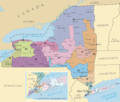
New York congressional districts from 2003 to 2013
Obsolete districts
- New York's 28th congressional district, obsolete since the 2010 U.S. Census.
- New York's 29th congressional district, obsolete since the 2010 U.S. Census.
- New York's 30th congressional district, obsolete since the 2000 U.S. Census.
- New York's 31st congressional district, obsolete since the 2000 U.S. Census.
- New York's 32nd congressional district, obsolete since the 1990 U.S. Census.
- New York's 33rd congressional district, obsolete since the 1990 U.S. Census.
- New York's 34th congressional district, obsolete since the 1990 U.S. Census.
- New York's 35th congressional district, obsolete since the 1980 U.S. Census.
- New York's 36th congressional district, obsolete since the 1980 U.S. Census.
- New York's 37th congressional district, obsolete since the 1980 U.S. Census.
- New York's 38th congressional district, obsolete since the 1980 U.S. Census.
- New York's 39th congressional district, obsolete since the 1980 U.S. Census.
- New York's 40th congressional district, obsolete since the 1970 U.S. Census.
- New York's 41st congressional district, obsolete since the 1970 U.S. Census.
- New York's 42nd congressional district, obsolete since the 1960 U.S. Census.
- New York's 43rd congressional district, obsolete since the 1960 U.S. Census.
- New York's 44th congressional district, obsolete since the 1950 U.S. Census.
- New York's 45th congressional district, obsolete since the 1950 U.S. Census.
See also
References
- "The national atlas". nationalatlas.gov. Archived from the original on February 22, 2014. Retrieved February 2, 2014.
- 2 U.S.C. § 2c
- "New Congressional Lines Imposed by Federal Court". New York Times. Retrieved June 27, 2012.
- Zremski, Jerry (July 21, 2020). "Chris Jacobs sworn in to Congress, appointed to Agriculture Committee". Buffalo News.
- The numbers which are used nowadays to describe these districts at this time derive from the numbers of the districts officially introduced in 1797, considering the sequence of the districts in the official listing and the approximate geographical equivalence.
- In the Act of March 23, 1797, the Towns of Clarkstown, Haverstraw, Hempsted and Orangetown are mentioned. These towns were split from Orange County in 1798, before the election, to form Rockland County.